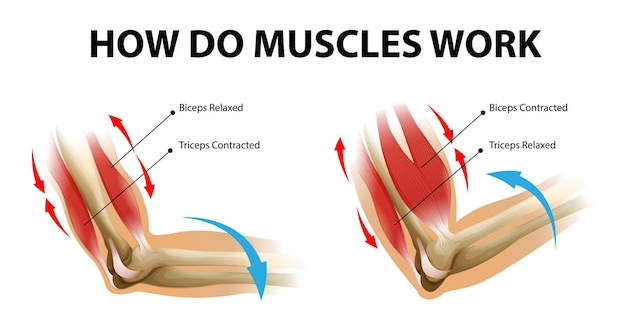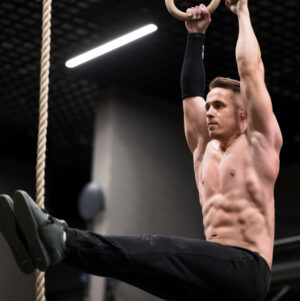The triceps and biceps are two of the most prominent muscle groups in the upper body. The triceps, located on the back of the upper arm, consists of three heads that work together to extend the arm. On the other hand, the biceps, situated on the front of the upper arm, comprises two heads responsible for flexing the arm.
Both the triceps and biceps muscles play essential roles in various daily activities and exercises, such as lifting, pushing, and pulling. Due to their involvement in these movements, they are susceptible to injuries, including tendonitis.
What is tendonitis and its causes?
Tendonitis is the inflammation of a tendon, which is the thick fibrous tissue that connects muscle to bone. It commonly occurs in athletes and individuals who engage in repetitive arm movements, such as weightlifting, throwing, and swinging a racket. Tendonitis can be caused by overuse, poor technique, or inadequate warm-up before exercise.
In the case of triceps and biceps tendonitis, the repetitive stress placed on the tendons can lead to inflammation, resulting in pain, swelling, and limited range of motion.

Triceps vs biceps: Anatomy and function
To understand the differences in tendonitis susceptibility between the triceps and biceps, it is crucial to examine their anatomy and function. The triceps muscle is larger and has three heads, namely the long head, lateral head, and medial head. These heads work together to extend the elbow joint and stabilize the shoulder.
On the other hand, the biceps muscle has two heads, the long head and short head, which originate from the scapula and merge into a single tendon, attaching to the radius bone in the forearm. The biceps muscle is responsible for flexing the elbow and supinating the forearm.
Common causes of triceps tendonitis.
Triceps tendonitis often arises from repetitive overuse or sudden increase in training intensity without proper conditioning. Some common causes of triceps tendonitis include:
1. Overtraining:
Engaging in excessive triceps exercises without allowing sufficient rest and recovery can lead to tendon inflammation and injury.
2. Poor technique:
Performing triceps exercises with incorrect form, such as excessive elbow flare during triceps extensions, can put undue stress on the tendons, leading to tendonitis.
3. Inadequate warm-up:
Failing to warm up adequately before engaging in triceps-focused workouts can increase the risk of tendonitis due to insufficient blood flow and muscle elasticity.
Common causes of biceps tendonitis.
Similarly, biceps tendonitis can be caused by a variety of factors, including:
1. Repetitive motions:
Repeatedly performing movements that involve flexing the elbow and supinating the forearm, such as biceps curls and hammer curls, can strain the biceps tendon and lead to inflammation.
2. Heavy weights:
Lifting weights that are too heavy for your current strength level can place excessive stress on the biceps tendon, making it more prone to injury and tendonitis.
3. Sudden increase in intensity:
Abruptly increasing the intensity or volume of biceps-focused exercises without allowing your tendons to adapt can result in tendonitis.

Symptoms and diagnosis of triceps tendonitis.
When it comes to triceps tendonitis, there are certain symptoms and diagnostic methods to consider. The most common symptoms include:
- Pain: Tenderness and pain in the back of the upper arm, particularly during triceps exercises or when extending the arm.
- Swelling: Visible swelling or inflammation around the triceps muscle.
- Limited range of motion: Difficulty fully extending the arm or experiencing discomfort when attempting to do so.
To diagnose triceps tendonitis, a healthcare professional may perform a physical examination, review medical history, and potentially order imaging tests, such as an ultrasound or MRI, to assess the extent of the injury.
Symptoms and diagnosis of biceps tendonitis.
Biceps tendonitis exhibits distinct symptoms that can aid in its diagnosis. These symptoms may include:
- Pain: Pain in the front of the upper arm, particularly during biceps exercises or when flexing the elbow.
- Weakness: Feeling weakened or having difficulty lifting objects due to biceps tendon inflammation.
- Clicking or popping: Sensations of clicking or popping in the shoulder joint when moving the arm.
To confirm the diagnosis of biceps tendonitis, a medical professional may conduct a physical examination, inquire about symptoms and medical history, and possibly order imaging tests like an MRI or X-ray.
Preventive measures for triceps and biceps tendonitis.
Prevention plays a crucial role in minimizing the risk of triceps and biceps tendonitis. By implementing the following preventive measures, individuals can safeguard their muscles and tendons:
- Gradual progression: Gradually increase the load and intensity of triceps and biceps exercises to allow the tendons to adapt and strengthen over time.
- Proper form and technique: Maintain correct form and technique during triceps and biceps exercises, ensuring that the load is evenly distributed and not concentrated solely on the tendons.
- Adequate rest and recovery: Allow sufficient time for rest and recovery between triceps and biceps workouts to prevent overuse and give the tendons ample time to heal.
Exercises to strengthen triceps and biceps without causing tendonitis.
While triceps and biceps exercises are essential for building strength and muscle mass, it is crucial to choose exercises that minimize the risk of tendonitis. Here are some exercises that can strengthen these muscle groups without causing tendonitis:
- Triceps: Close-grip push-ups, diamond push-ups, and dips are effective triceps exercises that engage the muscles without placing excessive stress on the tendons.
- Biceps: Concentration curls, hammer curls, and chin-ups are biceps exercises that target the muscles while minimizing strain on the tendons.
Importance of proper form and technique in triceps and biceps workouts.
Maintaining proper form and technique during triceps and biceps workouts is vital to prevent tendonitis and maximize muscle development. Some key points to remember include:
- Controlled movements: Perform triceps and biceps exercises with controlled and deliberate movements to minimize unnecessary stress on the tendons.
- Avoid excessive weight: Use weights that allow you to maintain proper form throughout the entire range of motion, avoiding the temptation to lift excessively heavy loads that could strain the tendons.
- Listen to your body: If you experience any pain or discomfort during triceps or biceps exercises, stop immediately and reassess your form or reduce the weight.

Recovery and treatment options for triceps and biceps tendonitis.
In the unfortunate event of triceps or biceps tendonitis, proper recovery and treatment are essential to restore the tendons to health. Some recovery and treatment options include:
- Rest: Allow the affected tendons to rest and recover by avoiding activities that exacerbate the pain and inflammation.
- Ice and heat therapy: Apply ice packs to the affected area to reduce inflammation, followed by heat therapy to promote blood flow and aid in healing.
- Physical therapy: Engage in targeted exercises and stretches prescribed by a physical therapist to gradually strengthen the tendons and restore proper function.
Conclusion: Maintaining healthy triceps and biceps.
In conclusion, both the triceps and biceps muscles are susceptible to tendonitis due to their involvement in various arm movements. By understanding the causes, symptoms, and preventive measures of triceps and biceps tendonitis, individuals can take proactive steps to protect these muscle groups.
Through proper form, gradual progression, and adequate rest and recovery, individuals can continue to strengthen their triceps and biceps without succumbing to tendonitis. Remember, maintaining optimal muscle health is crucial for overall well-being and long-term athletic performance.
So, let’s prioritize the health of our triceps and biceps to keep them strong, injury-free, and ready for any challenge that comes our way.
Remember, prevention is key! Take care of your triceps and biceps to avoid the pain and setbacks of tendonitis. Incorporate proper form, gradual progression, and regular rest into your training routine. Your muscles will thank you!


